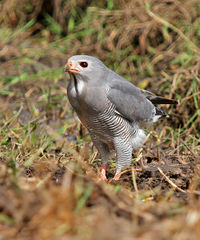Lizard Buzzard
 From Conservapedia
From Conservapedia | Lizard Buzzard | |
|---|---|

| |
| Scientific classification | |
| Kingdom Information | |
| Domain | Eukaryota |
| Kingdom | Animalia |
| Subkingdom | Bilateria |
| Branch | Deuterostomia |
| Phylum Information | |
| Phylum | Chordata |
| Sub-phylum | Vertebrata |
| Infraphylum | Gnathostomata |
| Class Information | |
| Superclass | Tetrapoda |
| Class | Aves |
| Sub-class | Neornithes |
| Infra-class | Neoaves |
| Order Information | |
| Order | Accipitriformes |
| Sub-order | Accipitres |
| Family Information | |
| Superfamily | Accipitroidea |
| Family | Accipitridae |
| Sub-family | Buteoninae |
| Genus Information | |
| Genus | Kaupifalco |
| Species Information | |
| Species | K. monogrammicus |
| Population statistics | |
| Population | Unknown (2016 est.)[1] |
| Conservation status | Least concern[2] |
The lizard buzzard (Kaupifalco monogrammicus) is a species of bird of prey of the family Accipitridae, and found throughout much of sub-Saharan Africa.
Contents
- 1 Description
- 1.1 Subspecies
- 2 Range and habitat
- 3 Diet
- 4 Reproduction
- 5 References
Description[edit]
The lizard buzzard is small, with a body length of 13.7 to to 14.9 inches, a wingspan of 47.2 inches, and weigh 8.81 to 9,87 ounces. Females are slightly larger than males. It is stocky in appearance, predominately light gray in color, slightly darker on the upper wings, with a white belly and legs marked by fine, black barring; it is also white around the eyes, at the throat and at the base of the tail. The undersides of the wings and the tail are light gray, with black-tipped primaries. Unique to this raptor, a central black stripe juts downward, from the beak to the base of the neck. The beak itself is orange with a black tip. The strong legs are orange and have sharp, black claws. Juveniles somewhat resemble adults, but the feathers that are black in the adults are rather brown in juveniles.
The calls are described as cries at once acute and a little muffled[3].
Subspecies[edit]
- Kaupifalco monogrammicus meridionalis; southern Kenya to Angola, Namibia and South Africa.
- Kaupifalco monogrammicus monogrammicus; Senegal and Gambia to Ethiopia and Kenya.
Range and habitat[edit]
It is found mainly in the savannas, bush areas, and sparse forests[4] of sub-Saharan Africa, up to 6,000 feet elevation.
Diet[edit]
The lizard buzzard feeds on small vertebrates, such as lizards, geckos, snakes, small mammals (rabbits, mice and other rodents) and young birds, and insects. It is either a still hunter, locating prey from a perch such as an isolated tree branch, or while in flight, hovering during its search for food. When the prey is sighted it plunges to the ground, killing with either its talons or a peck on the head (such as for snakes). The size of the prey depends on whether it is consumed directly on the ground or in higher vegetation.
Reproduction[edit]
Breeding occurs during the dry season. The lizard buzzard builds a nest of twigs on the fork of a tree or in the crown of a palm tree. It is built by both parents, one bringing the materials and the other taking care of the construction. The interior is lined with plant debris, moss and leaves. The female lays 1 to 3 white eggs, with incubation exclusively by her, while the male brings food and places it either in the nest or next to it. The chicks become completely independent at the age of approximately 90 days.
References[edit]
- ↑ https://www.iucnredlist.org/species/22695421/93508702#population
- ↑ https://www.iucnredlist.org/species/22695421/93508702
- ↑ https://www.xeno-canto.org/species/Kaupifalco-monogrammicus
- ↑ http://www.oiseaux-birds.com/card-lizard-buzzard.html
Categories: [Birds of Prey] [Hawks]
↧ Download as ZWI file | Last modified: 03/02/2023 14:14:20 | 18 views
☰ Source: https://www.conservapedia.com/Lizard_buzzard | License: CC BY-SA 3.0
 ZWI signed:
ZWI signed: KSF
KSF